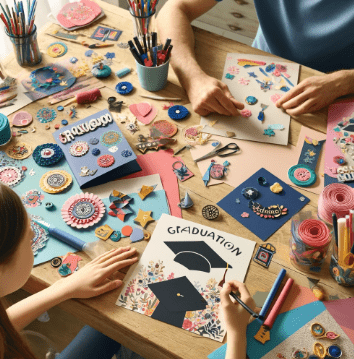Graduation is a significant milestone in any young person’s life, and what better way to celebrate it than by creating a personalized graduation card? Engaging your kids in designing their own graduation cards not only fosters creativity but also adds a personal touch to this special occasion. In today’s digital age, approximately 65% of greeting cards are now created online and printed, combining convenience with customization. Let’s dive into how you can help your children design high-quality, memorable graduation cards that stand out!
Starting with a Theme
The first step in creating a graduation card is choosing a theme that resonates with your graduate’s personality and achievements. Whether it’s academic excellence, sports achievements, or a journey through school memories, selecting a theme gives direction to the creative process. Discuss what themes are most meaningful to your child and what message they want to convey through their card. This could be a reflection of their future aspirations, a thank you to friends and family, or a celebration of their journey thus far.
Perfecting the Art of Graduation Announcements
Graduation announcements are a special way to share the exciting news of your child’s achievement with friends, family, and loved ones. When helping your child craft their graduation announcements, focus on conveying the joy and significance of this milestone. Start by choosing a design that complements the graduation card, maintaining a consistent theme and style. It’s important to include key information such as the graduate’s name, the date of graduation, and the name of the educational institution. Additionally, you might want to add a personal touch by including a brief message or a favorite quote that resonates with your child’s journey or aspirations. These announcements are not just informative; they’re a celebration of success and a beckon for future opportunities, making them a cherished keepsake for both the sender and the recipients.
Design Elements to Consider
When designing a graduation card, several elements can make the design both fun and impactful:
- Color Scheme: Choose colors that reflect the school’s colors, or opt for a palette that suits your child’s style. Bright and bold colors can make the card pop, while more subdued tones might reflect a serious academic focus.
- Typography: Select fonts that are easy to read but also carry a style that complements the overall design of the card. Mixing one or two fonts can add visual interest without cluttering the card.
- Images and Graphics: Include photographs from significant moments during their school years or use graphic elements that tie into the chosen theme. These could be anything from a cap and gown to symbols representing their school mascot or their field of study.
- Personal Messages: Perhaps the most important part of any graduation card is the message it carries. Help your child craft a personal message that expresses their gratitude, reflects on their journey, or shares their excitement for the future.
Making It Interactive
Incorporating interactive elements into the graduation card can make it even more engaging for those who receive it. Here are a few creative ideas:
- QR Codes: Include a QR code that links to a digital guestbook where friends and family can leave personal messages and well-wishes.
- Pop-Ups: Add a pop-up element inside the card for a fun surprise when the card is opened.
- Scratch-Offs: Use scratch-off stickers to conceal a special thank you message or a funny quote that the receiver can physically interact with.
These elements not only enhance the visual and tactile appeal of the card but also add an element of playfulness and surprise.
Emphasizing Quality and Durability
When crafting a graduation card, the quality of materials used can significantly impact the overall impression and durability of the final product. Encourage your children to select high-quality cardstock which will not only enhance the appearance of their cards but also ensure that they stand the test of time. You might also consider protective finishes such as lamination or UV coating, which can protect the card from fading and wear. This is particularly important for cards that recipients might want to keep as keepsakes. Teaching your children about these options not only helps in creating a better end product but also instills an understanding of quality and craftsmanship in their creative projects.
Sharing and Celebrating Creatively
Once the graduation cards are designed and ready, think about creative ways to share them. If you’ve opted for digital designs, consider setting up a virtual celebration where your child can present their card via a video call to family and friends. For physical cards, you could organize a small gathering or a mailbox drop-off that adheres to social distancing protocols if necessary. Encouraging your child to share their creation not only spreads joy but also gives them a sense of pride in their work. This act of sharing can be a profound moment of connection between your child and the important people in their life, celebrating this milestone in a personal and meaningful way.
Conclusion
Helping your kids design their graduation cards is a wonderful way to spend time together while doing something creative and productive. It allows them to express their individuality and to thank those who have supported them throughout their educational journey. With a little guidance on design principles and encouragement to inject their personality, you can help them create a graduation card that they’re proud to share. So grab your supplies, fire up your creativity, and help your child make a graduation card that truly celebrates their achievements and the bright future ahead.

